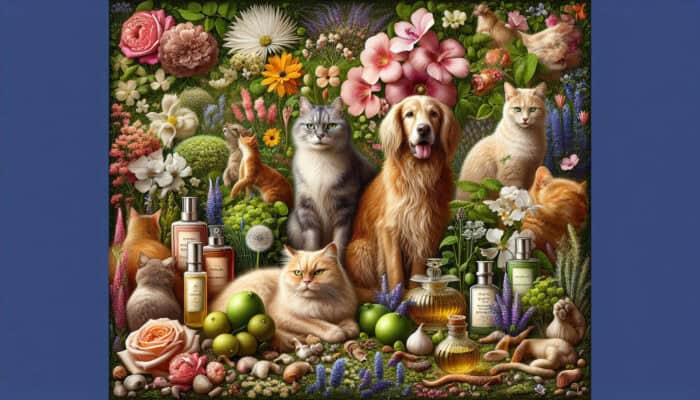Discover Safe and Natural Options for Pet Fragrance Alternatives
What Are the Top Pet-Friendly Fragrance Alternatives You Can Choose?

Pet fragrance alternatives are unique products specifically designed to refresh and eliminate odours from pets without utilising traditional perfumes, which often contain synthetic chemicals that can irritate a pet’s sensitive skin or provoke allergies. These natural solutions are formulated with pure ingredients that not only neutralise unpleasant smells but also contribute positively to a pet’s overall health and happiness. Available in various forms such as sprays, wipes, and powders, these options cater to a diverse array of pets, from dogs to cats, ensuring every furry friend can enjoy a pleasant aroma without the associated risks of synthetic products.
Selecting pet fragrance alternatives enables pet owners to make choices that prioritise the health and well-being of their beloved companions. As awareness increases surrounding the components found in pet care products, many pet parents are actively searching for safer and more sustainable options to keep their pets smelling delightful. This movement toward natural alternatives is transforming the pet care sector, as consumers increasingly demand transparency, quality, and safe ingredients in the products they choose for their cherished pets, fostering a healthier environment for both pets and their humans.
Why Is It Important to Choose Natural Ingredients for Your Pet’s Fragrance?
Choosing natural ingredients in pet fragrance alternatives presents numerous advantages for both pets and their owners. By opting for these products, pet owners can significantly reduce the likelihood of allergic reactions or skin irritations that often result from synthetic fragrances. Moreover, natural ingredients are generally more environmentally friendly, promoting a sustainable approach to pet care. Key benefits of using natural ingredients include:
- Minimised Allergic Reactions: Natural components are less likely to trigger allergies in pets.
- Environmental Responsibility: Many natural products are biodegradable and safe for the ecosystem.
- Enhanced Skin Health: Natural ingredients frequently offer additional skin benefits, such as moisturising properties.
- Long-Lasting Freshness: Many natural scents have deodorising qualities that can outlast synthetic fragrances.
By prioritising natural ingredients, pet owners not only improve their pets’ health but also make a positive impact on the planet’s well-being. This growing awareness is driving the pet care industry to innovate and produce more safe and effective products, aligning with the increasing demand for responsible pet ownership practices.
What Key Safety Considerations Should You Keep in Mind When Selecting Pet Fragrances?
When choosing pet fragrance alternatives, ensuring the safety of your furry friend should always be the highest priority. The components within these products can greatly influence a pet’s health, with some substances posing risks if ingested or absorbed through the skin. Here are crucial safety tips to consider when selecting pet fragrances:
- Thoroughly Review Ingredient Lists: Always scrutinise the ingredient list to avoid harmful chemicals or allergens.
- Look for Certifications: Opt for products that have been certified by reputable organisations, indicating that they have undergone thorough safety testing.
- Avoid Alcohol and Synthetic Fragrances: These can irritate the skin and may pose risks if licked by pets.
- Conduct a Patch Test: Before applying widely, test the product on a small area to observe for any adverse reactions.
By following these safety guidelines, pet owners can significantly reduce the risks related to pet fragrances, ensuring a safe and pleasant grooming experience for their treasured companions.
Gain Expert Guidance on Selecting Pet Fragrance Alternatives

What Insights Do Veterinarians Offer Pet Owners Regarding Fragrance Alternatives?
Veterinarians play a crucial role in guiding pet owners towards the safest and most effective fragrance alternatives for their furry friends. Many vets advocate for products that use natural ingredients known for their hypoallergenic properties and calming effects. A frequently recommended option among veterinarians is a lavender-based spray, celebrated not only for its lovely aroma but also for its soothing capabilities, particularly beneficial for anxious pets.
Additionally, products with ingredients like chamomile or aloe vera are often suggested due to their skin-soothing benefits. Brands such as “Burt’s Bees for Pets” offer a wide array of natural grooming products, including deodorising sprays that receive positive endorsements from veterinary professionals. Engaging in consultations with veterinarians allows pet owners to receive tailored recommendations that prioritise the safety and health of their pets, ensuring informed choices that support their furry friends’ well-being.
How Can Pet Owners Identify Quality Pet Fragrance Products?
Recognising high-quality pet fragrance alternatives necessitates a keen eye for detail. Pet owners should look for products that feature clear and transparent ingredient lists, outlining the components used. Actionable steps to ensure product quality include:
- Research Brands: Choose brands that have established a solid reputation and received positive customer reviews.
- Seek Natural Certifications: Look for products with certifications that validate they are made from natural ingredients.
- Check for Veterinary Endorsements: Endorsements from veterinary professionals can indicate reliability and safety.
- Examine Packaging: Quality products often come in packaging designed to prevent contamination.
By implementing these strategies, pet owners can confidently select products that are not only effective but also safe for their pets. This proactive approach empowers pet owners to make informed decisions that align with their pets’ overall health and wellness.
What Are the Emerging Trends in Pet Fragrance Alternatives?

The pet care industry is in a constant state of evolution, with innovative trends emerging in the field of pet fragrances. One notable trend involves the integration of aromatherapy principles, where fragrances are crafted to promote relaxation and calmness for pets, utilising ingredients such as bergamot and ylang-ylang. This movement towards wellness-oriented fragrances illustrates a growing awareness among pet owners regarding the emotional and psychological needs of their furry companions.
Furthermore, there is an increasing demand for sustainable packaging and eco-friendly formulations, as consumers strive for products that minimise their environmental impact. Brands are now introducing refillable options and biodegradable packaging, appealing to eco-conscious customers. Expert analyses suggest that these trends not only elevate the pet grooming experience but also attract a broader audience seeking holistic care solutions for their pets.
Are Natural Fragrance Alternatives More Beneficial for Pets?
Natural fragrance alternatives are often viewed as more advantageous for pets due to their formulations with ingredients that are generally safer and more beneficial than synthetic options. Fragrances derived from natural sources provide numerous benefits, including calming effects and a lower likelihood of adverse reactions. However, it is vital to acknowledge that not all natural ingredients are inherently safe; some can pose toxicity risks to pets if ingested or used incorrectly.
Experts emphasise the importance of choosing high-quality natural alternatives that are specifically designed for pets. Products infused with essential oils like cedarwood or rosemary can offer pest-repelling qualities along with pleasant fragrances, making them both safe and functional. Pet owners must remain knowledgeable and vigilant about the specific ingredients in these products to ensure they are making the best choices for their cherished companions.
How Do Scents Influence Pet Behaviour?
The influence of scents on pet behaviour is a captivating area of study, with various aromas eliciting different responses from animals. Certain fragrances can induce calming effects, aiding in the relaxation of anxious pets, while others may evoke excitement or agitation. For instance, aromas such as lavender and chamomile are commonly included in calming sprays, which can help alleviate stress during travel or grooming sessions.
Insights from animal behaviour specialists reveal that familiar scents can provide comfort for pets, while unfamiliar or overpowering fragrances may induce anxiety or discomfort. Pet owners should take their pets’ unique preferences and sensitivities into account when selecting fragrances. By observing their pets’ reactions to different scents, owners can tailor their selections to cultivate a peaceful and serene environment for their furry companions.
Essential Guidelines for Selecting the Perfect Pet Fragrance Alternative
Which Ingredients Should Be Prioritised in Pet Fragrance Products?
Choosing the optimal pet fragrance alternative requires an understanding of which ingredients are safe and beneficial for your pet’s skin and coat. Pet owners should focus on naturally derived components that effectively deodorise without jeopardising their pet’s health. Safe ingredients to highlight include:
- Aloe Vera: Renowned for its soothing properties, making it ideal for sensitive skin.
- Chamomile: Provides calming effects and is gentle on the skin.
- Lavender: Offers a pleasant scent alongside natural calming benefits.
- Essential Oils: Such as cedarwood, known for its natural pest-repelling qualities.
By concentrating on these ingredients, pet owners can select products that not only keep their pets smelling delightful but also promote their overall skin health. It is essential to avoid harsh chemicals and synthetic fragrances, as these can lead to skin irritations or allergic reactions, ultimately compromising the pet’s well-being.
How Can You Tailor Products to Meet Your Pet’s Unique Needs?
Properly matching the right pet fragrance alternative to your pet’s individual requirements is crucial for achieving the best results. Different pets have unique needs based on their skin type, coat condition, and sensitivities. Understanding your pet’s specific characteristics can effectively guide your choices. For instance, pets with sensitive skin may benefit from hypoallergenic formulations, while those with thicker coats might require deeper cleansing and deodorising properties.
Additionally, consider your pet’s lifestyle: active pets that frequently engage in outdoor activities may need stronger deodorising properties, while indoor pets may only require mild fragrances to maintain freshness. By evaluating both the pet’s physical needs and lifestyle, owners can select products that enhance their grooming routines and positively impact their pets’ overall quality of life.
Where Can You Access Trustworthy Reviews for Pet Fragrance Alternatives?
Finding reliable reviews can significantly aid pet owners in making informed decisions regarding pet fragrance alternatives. Reputable pet care websites and forums typically offer thorough reviews and shared experiences from fellow pet owners. To ensure the reliability of reviews, it is advisable to seek platforms featuring verified purchases and detailed user experiences.
Additionally, explore well-established pet blogs or veterinarian websites that provide insights into various products, focusing on safety and efficacy. Social media platforms can also serve as valuable resources; many pet owners share their experiences and recommendations, providing a broader perspective. By utilising these sources, pet owners can gather diverse opinions to help them make educated choices regarding pet fragrance alternatives.
Best Practices for Applying Pet Fragrance Alternatives Effectively
How to Safely Apply Pet Fragrance Alternatives to Your Furry Friend?
Applying pet fragrance alternatives safely necessitates careful consideration of the quantity used and the technique employed to avoid overwhelming your pet. It’s crucial to start with a minimal amount of product; typically, a few spritzes or dabs will suffice, depending on the formulation. When applying, focus on areas where the scent can disperse without being overly concentrated, such as the back of the neck or along the spine.
Avoid spraying near the face or sensitive areas, including the eyes, ears, and nose. If using a wipe or spray, ensure the product is evenly distributed and not excessively saturated, as this can lead to discomfort or irritation. Monitoring your pet’s behaviour during and after application is essential; if your pet exhibits signs of distress or discomfort, discontinue use immediately. This careful approach ensures a positive experience, allowing your pet to enjoy the fresh scent without negative consequences.
What Is the Ideal Frequency for Application of Pet Fragrance Alternatives?
Determining the appropriate frequency for using pet fragrance alternatives is vital for maintaining their effectiveness without overuse. Generally, applying these products once or twice a week is sufficient to keep your pet smelling fresh. However, this may vary based on your pet’s activity level and grooming routine. For instance, a pet that spends considerable time outdoors may require more frequent applications compared to an indoor pet.
Pet owners should observe their pets and adjust accordingly; if your pet develops a strong odour between applications, it may indicate a need for more frequent use. Conversely, if the scent lasts longer than expected, consider reducing the frequency to avoid overwhelming your pet. Striking the right balance ensures that the fragrance alternative positively contributes to your pet’s freshness without causing any adverse effects.
What Are the Best Storage Practices for Pet Fragrance Alternatives?
Proper storage of pet fragrance alternatives is essential for prolonging their shelf life and preserving their efficacy. Ideally, these products should be kept in a cool, dry location away from direct sunlight to prevent ingredient degradation. Exposure to heat and light can alter the formulation, diminishing its effectiveness and possibly leading to harmful reactions.
Keep the product tightly sealed when not in use to prevent contamination or evaporation of essential oils. Moreover, it’s wise to adhere to any expiration dates indicated on the packaging; expired products should be disposed of, as they may not perform as intended. By implementing these storage practices, pet owners can ensure that their chosen fragrance alternatives remain safe and effective for their furry companions.
Common Natural Ingredients in Pet Fragrance Alternatives
What Are the Most Frequently Used Natural Fragrances in Pet Products?
Commonly utilised natural fragrances in pet fragrance alternatives feature a variety of pleasant and pet-safe scents. Ingredients such as lavender, chamomile, and citrus extracts are frequently included in formulations designed for pets. Lavender is especially noted for its calming effects, making it an excellent choice for pets prone to anxiety. Chamomile also offers soothing benefits, promoting relaxation and comfort.
Citrus extracts, like lemon or orange, provide uplifting aromas while serving as natural deodorising agents. Other popular natural fragrances include rosemary and eucalyptus, renowned for their refreshing scents and additional benefits such as pest-repellent properties. These fragrances not only keep pets smelling lovely but also positively impact their overall well-being, aligning with the increasing trend towards organic and holistic pet care solutions.
How Do Essential Oils Benefit Pets When Used in Fragrance Products?
Essential oils can provide a multitude of benefits to pets when utilised appropriately, offering both therapeutic and aromatic advantages. Certain oils, such as lavender and chamomile, are highly regarded for their calming properties, which can help alleviate anxiety and stress in pets. Other oils, like peppermint, may provide relief from minor discomforts, acting as a natural remedy for various issues.
Additionally, essential oils can act as natural pest repellents. For instance, oils such as cedarwood and lemongrass can deter fleas and ticks, adding an extra layer of protection for pets. However, it’s crucial to remember that not all essential oils are safe for pets; some can be toxic if ingested or improperly applied. Therefore, pet owners should prioritise oils that are known to be safe and effective, ensuring they enhance their pets’ health without posing any risks.
What Potential Risks Are Associated with Natural Ingredients in Pet Fragrances?
While natural ingredients are generally regarded as safer alternatives, there are still potential risks that pet owners should be mindful of. Certain natural substances can provoke allergic reactions or skin irritations in some pets, particularly those with pre-existing sensitivities. It’s essential to remain vigilant and monitor for any adverse reactions when introducing new products.
Additionally, some natural ingredients can be toxic if ingested in excessive amounts. For instance, while essential oils can provide various benefits, certain oils like tea tree or eucalyptus can be harmful. Pet owners should educate themselves about the specific ingredients in their chosen fragrance alternatives and adhere to recommended usage guidelines. Implementing precautions, such as conducting a patch test on a small area first, can help mitigate the common pitfalls associated with natural pet fragrances.
DIY Pet Fragrance Alternatives: Create Your Own
How to Craft Your Own Pet Fragrance at Home?
Creating your own pet fragrance alternative can be an enjoyable and cost-effective way to ensure the use of safe ingredients tailored to your pet’s preferences. A simple DIY recipe involves mixing water with a few drops of pet-safe essential oils in a spray bottle. For example, combining 1 cup of distilled water with 5-10 drops of lavender essential oil can yield a refreshing and calming scent for your pet.
Another method is to infuse water with herbs such as chamomile or rosemary, allowing the mixture to cool before straining and transferring it to a spray bottle. This natural approach not only grants pet owners control over the ingredients but also allows for personalisation based on their pet’s reactions and preferences. As DIY fragrances can be produced in small batches, pet owners can experiment with various blends to discover the perfect scent for their furry companions.
What Ingredients Are Safe for DIY Pet Fragrance Recipes?
Selecting the appropriate ingredients for DIY pet fragrance alternatives is crucial to ensure they are both safe and effective. Some pet-safe ingredients include:
- Distilled Water: Serves as a base for sprays.
- Lavender Essential Oil: Renowned for its calming properties.
- Chamomile Tea: Offers soothing benefits when infused.
- Rosemary Essential Oil: Provides a refreshing scent and has natural pest-repelling properties.
These ingredients can be combined to create a desirable scent while ensuring the final product remains safe for pets. It’s essential to avoid any oils or ingredients known to be toxic to pets, ensuring a beneficial DIY experience that prioritises their safety and well-being.
How to Ensure Safety in Your DIY Pet Fragrance Creations?
Ensuring the safety of DIY pet fragrance alternatives necessitates careful selection of ingredients and proper formulation. Start by researching which essential oils are considered safe for pets and avoid any that are known to be toxic. Always use high-quality, pure essential oils to minimise the risk of harmful additives.
It’s also crucial to formulate the fragrance in appropriate dilutions; essential oils should never be applied in full strength on pets. When creating a spray, a general guideline is to use 1-2% essential oil in the mixture to ensure it remains safe for pet use. Additionally, pet owners should test the fragrance on a small area of their pet’s skin to check for any adverse reactions prior to full application. By adhering to these safety measures, pet owners can confidently create DIY fragrances that are both enjoyable and safe for their furry companions.
Research-Backed Benefits of Pet Fragrance Alternatives
What Do Studies Reveal About the Advantages of Pet Fragrance Alternatives?
Research has indicated that certain pet fragrance alternatives can produce positive effects on pet health and well-being. Studies have shown that specific scents, particularly those derived from natural sources, can help alleviate stress and anxiety in pets, creating a calming atmosphere. For example, a study published in a veterinary journal examined the effects of lavender essential oil on canine behaviour during stressful situations, revealing that dogs exposed to the aroma exhibited significantly reduced signs of anxiety.
Moreover, products that effectively integrate natural ingredients into their formulations have been found to improve skin conditions in pets, especially for those suffering from allergies or sensitivities. By utilising ingredients recognised for their soothing properties, pet fragrance alternatives can enhance the overall quality of life for pets. These findings endorse the notion that thoughtfully selected fragrances and formulations can positively contribute to a pet’s emotional and physical health.
How Do These Products Affect Pet Behaviour?
Certain pet fragrance alternatives can influence pet behaviour, with specific scents known to reduce anxiety or promote calmness. For instance, fragrances such as lavender and chamomile have been acknowledged for their soothing effects, making them particularly beneficial during stressful situations like veterinary visits or travel. The calming properties of these scents can assist in alleviating anxiety, resulting in a more relaxed disposition in pets.
To effectively utilise these products for behavioural enhancement, pet owners should observe their pets’ reactions to various scents and apply the fragrance alternatives strategically during known stressors. By incorporating calming fragrances into their grooming routine, pet owners can foster a positive environment that enhances their pets’ emotional well-being.
What Are the Long-Term Benefits of Using Pet Fragrance Alternatives?
Understanding the long-term effects of utilising pet fragrance alternatives can guide pet owners in making informed choices regarding their pets’ grooming needs. Research suggests that consistently using high-quality, natural products can lead to improved skin health and overall well-being for pets, particularly for those susceptible to allergies or sensitivities. Over time, these positive impacts can result in healthier skin and fur, contributing to the pet’s comfort and happiness.
In contrast, the prolonged use of products containing harsh chemicals or synthetic fragrances may lead to negative effects, including skin irritations or allergic reactions. Therefore, pet owners should prioritise natural alternatives that align with their pets’ needs, ensuring a sustainable grooming approach that supports their overall health in the long run.
Exploring Alternatives to Conventional Pet Fragrances
How Do Pet Shampoos Serve as Effective Alternatives?
Pet shampoos can effectively function as an alternative to traditional pet fragrances, providing cleansing and scent benefits within a single product. Many pet shampoos now incorporate natural fragrances derived from essential oils, offering the dual functions of cleaning and deodorising. The primary advantage of pet shampoos is that they not only eliminate dirt and odours but also leave a pleasant scent after bathing.
However, it’s essential to weigh the pros and cons of using shampoos solely for fragrance purposes. While shampoos can effectively maintain freshness, frequent washing can strip natural oils from the skin, leading to dryness or irritation. Thus, pet owners should balance regular bathing with the use of deodorising sprays or wipes to sustain their pets’ freshness without compromising skin health.
What Advantages Do Pet Cologne Sprays Offer?
Pet cologne sprays represent another viable option for pet owners seeking alternatives to traditional fragrances. These sprays are specifically formulated for pets, often employing natural ingredients to achieve pleasant scents while ensuring safety. Unlike conventional perfumes, which may contain harsh chemicals, pet colognes focus on gentle formulations designed for animal use.
When comparing pet cologne sprays to standard perfumes, safety is a crucial differentiator. Pet colognes are crafted with pets’ sensitivities in mind, minimising the risk of irritation or allergic reactions. Furthermore, these sprays often contain natural fragrances that can provide additional benefits, such as calming effects or even pest-repelling properties. For pet owners looking for a quick and safe way to freshen their pets, cologne sprays can serve as an excellent substitute for traditional products.
Are Fragrance-Free Options Available for Pets?
For pet owners who prefer to avoid any fragrance, fragrance-free options are available that can still maintain pet freshness. These products typically focus on neutralising odours instead of masking them with artificial scents. By utilising natural deodorising agents like baking soda, activated charcoal, or certain plant-based ingredients, unpleasant smells can be effectively managed without introducing any fragrance.
Fragrance-free wipes or sprays can be particularly beneficial for quick touch-ups between baths, allowing pet owners to keep their pets smelling fresh without the risk of overwhelming scents. Additionally, opting for fragrance-free grooming tools and pet bedding can significantly contribute to an overall clean environment for pets, ensuring they remain comfortable and fresh without relying on artificial fragrances.
Maintaining Your Pet’s Freshness Without Relying on Fragrance
How to Keep Your Pet Naturally Fresh and Clean
Maintaining your pet’s freshness without the use of fragrance involves a combination of regular grooming and natural deodorising techniques. Consistent brushing not only removes dirt and loose fur but also distributes natural oils throughout the coat, promoting a healthy shine and natural scent. Bathing your pet with a gentle, natural shampoo can further enhance cleanliness without depending on artificial fragrances.
In addition to grooming, employing natural deodorising methods can assist in maintaining freshness. For example, sprinkling baking soda on pet bedding or utilising natural herbal sachets can absorb odours while avoiding synthetic scents. These strategies create an environment where pets can remain naturally fresh, minimising the necessity for additional fragrance applications.
Which Dietary Choices Can Influence Pet Odour?
A pet’s diet plays a significant role in their overall odour, with specific foods contributing to fresher breath and healthier skin. High-quality, well-balanced diets rich in omega fatty acids can improve coat health and reduce unpleasant smells emanating from the skin. Conversely, low-quality diets or those containing fillers can lead to digestive issues, resulting in more pronounced odours.
Incorporating foods that promote good digestion, such as probiotics or certain fruits and vegetables, can also help manage pet odours. Adjusting your pet’s diet to include these beneficial nutrients can lead to an overall reduction in unwanted smells, ensuring that your furry companion remains fresh and healthy.
How to Tackle Specific Odour Issues in Pets?
Addressing particular odour concerns, such as bad breath or anal gland issues, requires targeted solutions to keep your pet smelling fresh. For bad breath, regular dental care is crucial—consider using dental chews or water additives designed to combat odour-causing bacteria. Routine teeth brushing can also significantly enhance oral hygiene and mitigate bad breath.
For pets experiencing anal gland problems, consulting with a veterinarian is advisable to determine the best course of action, as expressed glands can lead to unpleasant odours. Furthermore, regular grooming and bathing can help manage bodily odours, ensuring that your pet remains clean and fresh. Addressing these specific odour issues with dedicated care can foster a more pleasant environment for both pets and their owners.
How Frequently Should You Bathe Your Pet for Optimal Freshness?
Regular bathing is essential for maintaining pet freshness, but it’s vital to find the right balance, as excessive bathing can strip natural oils from their skin. For most pets, bathing every 4-6 weeks is adequate, although this may vary based on their lifestyle and coat type. Active pets may require more frequent baths, particularly if they spend significant time outdoors, while less active pets might need fewer grooming sessions.
When bathing, it’s important to use a gentle, pet-safe shampoo that preserves the coat’s natural oils. Additionally, keep an eye on your pet’s skin condition; if you observe dryness or irritation, consider extending the interval between baths. By establishing a consistent bathing routine tailored to your pet’s needs, owners can successfully maintain freshness while ensuring their furry companions remain healthy and comfortable.
The Importance of Maintaining a Clean Living Environment for Pets
A clean living environment is crucial in minimising odours, contributing to a fresher atmosphere for both pets and their owners. Regularly washing pet beds, toys, and litter areas helps sustain cleanliness and eliminate sources of unpleasant smells. Furthermore, frequent vacuuming can remove pet hair and dander, enhancing the overall freshness of the home.
Consider utilising natural cleaning solutions for household surfaces, as these can effectively reduce odours without introducing harsh chemicals. Creating a clean environment not only fosters a pleasant living space but also promotes the overall health and well-being of pets, ensuring they remain happy and fresh.
Frequently Asked Questions About Pet Fragrance Alternatives
What Are the Most Effective Natural Ingredients for Pet Fragrances?
The most effective natural ingredients for pet fragrances include lavender, chamomile, aloe vera, and essential oils like cedarwood and rosemary, which are celebrated for their soothing and pest-repelling properties.
Is It Safe to Use Human Perfume on Pets?
Using human perfume on pets is not advisable due to the presence of synthetic chemicals that can irritate their sensitive skin and respiratory systems.
How Often Should Pet Fragrance Alternatives Be Applied?
Pet fragrance alternatives can typically be applied once or twice a week, although this may vary depending on your pet’s activity level and grooming needs.
Are DIY Pet Fragrances Safe to Use?
DIY pet fragrances can be safe if made with pet-safe ingredients and appropriate dilutions of essential oils. Always perform a patch test on a small area first.
What Ingredients Should Be Avoided When Selecting Pet Fragrances?
Avoid products containing alcohol, synthetic fragrances, or ingredients known to be harmful to pets, such as certain essential oils like tea tree or eucalyptus.
How Can I Maintain My Pet’s Freshness Without Using Fragrance?
Regular grooming, appropriate bathing, and maintaining a clean living environment can help keep pets smelling fresh without the need for fragrance.
What Signs Indicate an Allergic Reaction to Pet Fragrances?
Signs of allergic reactions may include itching, redness, swelling, or excessive scratching. If you notice these symptoms, discontinue use immediately.
Is There a Difference Between Pet Colognes and Pet Fragrances?
Yes, pet colognes typically have lighter scents and are formulated specifically for pets, while fragrances may contain stronger scents and potentially harmful ingredients.
Can Pets Be Affected by Strong Scents?
Yes, pets can be sensitive to strong scents, which may cause discomfort or anxiety. It’s best to use mild fragrances and avoid overwhelming your pet.
How Can I Determine If a Product Is Safe for My Pet?
To determine if a product is safe, check for clear ingredient lists, look for vet endorsements, and ensure it is formulated specifically for pets.
Connect with us on Facebook!
The Article Perfume Alternatives For Pets: Safe And Natural Options First Published On https://elgatoencasa.com
The Article Safe and Natural Perfume Alternatives for Pets Was Found On https://limitsofstrategy.com



